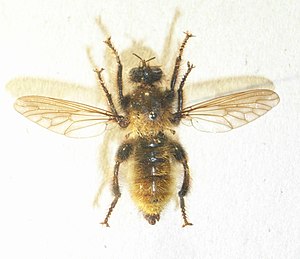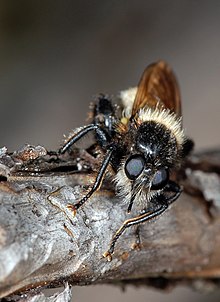Yellow predator fly
| Yellow predator fly | ||||||||||||
|---|---|---|---|---|---|---|---|---|---|---|---|---|

Yellow predator fly ( Laphria flava ), male |
||||||||||||
| Systematics | ||||||||||||
|
||||||||||||
| Scientific name | ||||||||||||
| Laphria flava | ||||||||||||
| ( Linnaeus , 1761) |
The yellow robber fly or yellow murder fly ( Laphria flava ) is a two-winged fly from the family of predatory flies (Asilidae).
features
The size of the yellow predator flies is variable, they reach a body length of 12 to 25 millimeters and are strongly built. The animals have thick hair, which is yellow and black in color. The animal is reminiscent of a bumblebee . The front half of the chest is covered with short, yellow hair, the rear part of the chest has thick, long hair of the same color, which is directed backwards. The abdomen and legs are also hairy.
Occurrence
The species occurs in almost all of Europe and is distributed in the east to Central Asia and Siberia . It is not uncommon to find it on sunny forest edges, on clearings and forest paths. She sunbathes on tree stumps, large flowering plants or piles of wood and looks for prey.
Way of life
The flight time of the yellow predator fly is between April and September. It flies with a clearly audible hum, which increases the impression of a bee or a bumblebee for humans, but it cannot sting. She chooses tree stumps or piles of wood to sit on and after short sightseeing flights she always returns to the chosen place. It hugs the substrate and folds its wings over the abdomen.
nutrition
From her vantage point, she looks out for prey. Her very agile head and good eyes enable her to spot and hunt flying insects. It hunts insects up to a size that matches its own. With its powerful proboscis it can reach the cuticle of insects, e.g. B. also from soft beetles and other small to medium-sized beetles, pierce and suck them out.
Reproduction
After mating, the females lay the eggs in tree trunks and rotten wood, usually in the boreholes of other insects. The Laphria larvae develop in the burrows of wood-dwelling insects and feed there mainly on their larvae, e.g. B. of bark beetle and longhorn beetle larvae .
Taxonomy
The yellow predator fly is one of 19 species of the genus Laphria found in Europe . The fly was already described by Carl von Linné in 1761, the specific epithet flava (lat. Flavus for "light yellow") indicates the light yellow color of the hair on the chest and abdomen. The German language name Mordfliege was introduced by the Diptera researcher Johann Wilhelm Meigen , who also established the genus Laphria .
Individual evidence
- ↑ Flight times of predatory flies in Germany table at Asilidae.de
- ^ Johann Wilhelm Meigen: Systematic description of the known European two-winged insects. With Friedrich Wilhelm Forstmann, Aachen 1818–1838
literature
- Heiko Bellmann: Insects . 2nd edition, Steinbach's natural guide, Eugen Ulmer Verlag, 2010, p. 145, ISBN 978-3-8001-5931-4
- Heiko Bellmann: The new cosmos insect guide. Franckh-Kosmos, Stuttgart 2009, p. 228, ISBN 978-3-440-11924-2
Web links
- Laphria flava at Fauna Europaea
- Yellow murder fly wanted poster at Insektenbox.de


